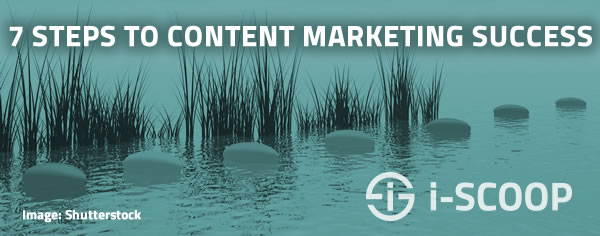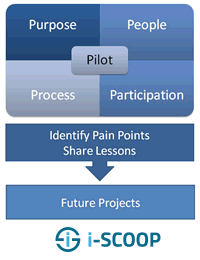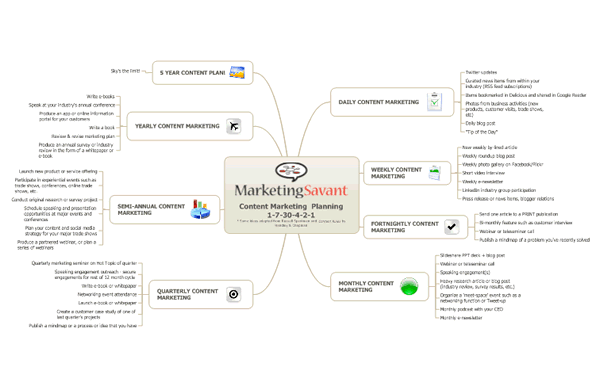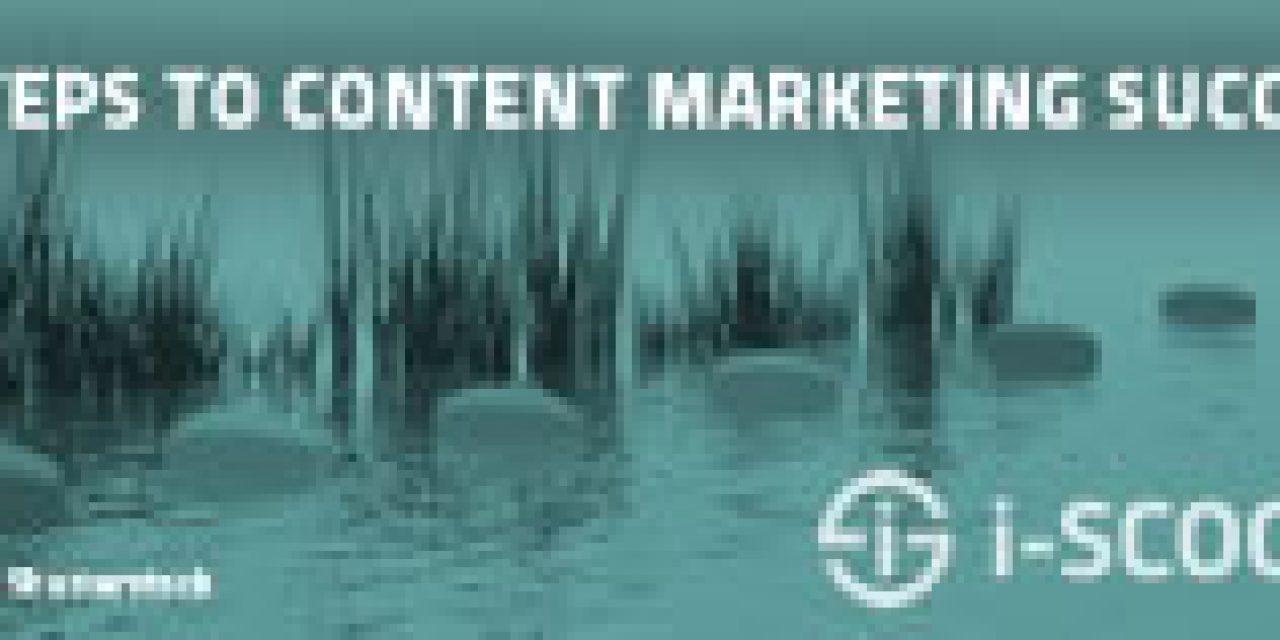Discover 7 steps to content marketing success and a second 7-step plan, to get started with content marketing, including frameworks and additional content marketing strategy resources (charts and frameworks at the bottom of this page).

Let’s start with the 7 steps to content marketing success and a bit of context: in April 2014, HubSpot and Smart Insights conducted research regarding the state of content marketing in Europe. On top of data, both also wanted to provide content marketing success advice, based on the research and spiced with some comments/quotes. HubSpot asked us to share our views and those of many others. You can read an overview of the results and data here.
We contributed and so did several content marketing practitioners and thought leaders, including Doug Kessler, James Carson, Stephen Bateman and Daniel Rowles, among others. The result: a collaborative eBook which we cover here for you in-depth and with many additional tips and advice to achieve content marketing success.
Driving content marketing success: paper, infographic and tips
The paper HubSpot created (along with a very informative infographic, mapping the different steps, see below) was done in collaboration with Smart Insights, a very good website on digital marketing by Dave Chaffey. Dave developed the RACE framework for digital marketing, which is mentioned in our list with frameworks for smart content marketing programs, wrote several books and papers, and was a speaker at some of our conferences.

Dave also wrote this paper, along with HubSpot’s Kieran Flanagan, the company’s EMEA Marketing Director. It is called “Driving content marketing success in 2014”. The infographic goes by the name “7 steps to success competing with content marketing”. OK, enough background, here we go with a first additional tip to kick off.
Content marketing success rule 1: no one-size-fits-all
Of course, the question which factors make you succeed in content marketing depends on the context of your organization, market and customers. Even more importantly, it also depends on your resources, degree of maturity regarding collaboration, (integrated) marketing, integrating processes and platforms (IT does matter) and so much more.
So, here’s an overview of the 7 steps with a bunch of additional links and tips.
Note: although it’s called the “European edition”, this European dimension (mostly UK anyway) only applies to the research, not to the content marketing success factors and additional tips below, which we tried to make as universal as possible.
The 7 steps to success “competing with content marketing”
1. Benchmark your current use of content marketing.
Do you know what content marketing (success) is and looks like? Do you use content marketing? Do you know why? To what extent are you using it, if at all? Do you know for who and for what reasons you create additional content or repurpose existing content? Do you know where the stories and content sit in your organization? The customer questions? Can you find them? Capture them? Before you know where to go – and not starting to create content for the whole world (that doesn’t care at all) – it’s nice to know where you stand and want to stand tomorrow and for what reasons and for whom.

Tip: getting a whole business on board is cool, getting a pilot up with a limited team and scope (and growth path) is also cool and often more realistic and doable. Additional bonus: with a good pilot, people get interested (success attracts) and it’s easier to make the case + you learn a lot!
We’ve been defending pilot projects (not as one-off content projects but in an integrated approach) in other areas such as social business forever (even if certain conditions need to be present) – more about pilot projects and those conditions and success factors + benefits in a social business context (where content marketing plays a role too) in this article.
“Those organizations that develop content marketing within a measurement focused strategy have the greatest chance of achieving their business objectives. An ad-hoc and scattered approach to content marketing will become increasingly unlikely to work as the market matures”. Daniel Rowles
2. Develop a content marketing strategy.
This includes all the stuff just mentioned. Have a plan, have goals, know whom you want to “engage” and on what grounds they would even care to engage, let alone, pay attention. Know what engagement would be in tangible outcomes (measuring). See what needs to be done, how much it costs (don’t forget the cost of opportunity), if you have the resources (or need additional ones), make the case if the expected outcomes are good and if you know how to measure at least some KPIs. The rest is planning, a roadmap and people (don’t forget to listen). On a more ‘technical’ and ‘strategic’ level this is also where the content audit and content gap analysis come in. Oh, and content marketing is not an island.
Read more about content marketing strategy.
Tip: when thinking about how to plan the content program from a practical resources viewpoint, never copy a pure “publisher model” just like that. You don’t need to be a publisher, you need to be a customer experience and value creation expert. It’s not about nifty job titles or nice models, it’s about roles and “who can/will do what today, tomorrow and next year” to make it – collaboratively – happen. You’ll rarely find a company (except for some big brands and organizations where content is at the core of the business model) where roles are not spread over people with other duties. And that’s normal too: content marketing is integrated marketing and your social, email, sales, customer service teams (to name just a few), play a role too.
“The greatest challenge for content marketing is often in the boardroom. The fear of sharing too much knowledge is a threat to content creation. Gather an evidence base to convince the senior team”. Annmarie Hanlon
3. Understand customer and brand needs from content.
Here we try to find that famous intersection where business needs (and the brand position and essence of the value proposition as Ardath Albee and Doug Kessler like to emphasize) meet the customer needs (and intent). We’re talking about personas (although you don’t always want to work with buyer personas, it depends), the customer journey, calendars, you name it.
Tip: don’t make your processes and calendars too hard or no one will use them. Adapt processes to goals and people, not the other way around.
Tip 2: for some tasks you might need content marketing software, chose wisely – read some tips on how to pick content marketing software here.
Read about personas in general and other models to identify “audiences”.
4. Make the smart investments in content marketing.
This seems obvious but for many it’s not. Prioritize and find the proper mix. Outsource when it makes sense (and that’s highly individual), train where it makes sense and plan to succeed on the levels of content creation and promotion. Smart investments obviously also means measurement.
Tip: even if there’s often an “outsourced” versus “in-house” debate regarding content marketing, the reality is hybrid and adaptive. Talk with IT people or project managers, they’ll know what you mean.
Tip 2: if you don’t have an overall marketing ROI program in your organization (most don’t) or have no idea where to start measuring: stay as close as possible to your goals when defining what can be measured and how to do it.
Tip 3: you don’t need to be able to measure everything (right now). Measurement is not a holy grail. Measure what you can measure and what makes sense, keeping into account that there’s a cost to measuring too. But, DO measure and gradually measure MORE and BETTER.
Tip 4: depending on circumstances, it’s often good to have a Center of Excellence. That seems like an expensive term – and it is really – but it works very well, if there’s a “human”, cultural and collaborative match. Working with a Center of Excellence has been used in IT, business intelligence and digital marketing, to name just a few, forever. In fact, it’s used in transformational processes where there’s a need for horizontal, cross-silo, diagonal, vertical, in-house, outsourced and whatnot collaboration. Do you need a CoE for content marketing? It doesn’t hurt if you want to work in an integrated way or make some people work together that have to make your plan happen. They all have different backgrounds, skills, motivations and so on. If you already have a CoE for digital marketing or other business processes, connect them! By drinking a beer (or something else) together now and then, having regular calls and the proper motivation, your CoE will run. The extra bonus: your internal staff will learn from all other stakeholders (even if your CoE is just 3 people in, let’s say a pilot or a small business). We talked about CoE’s previously, as in this summary of the research HubSpot and Smart Insights conducted.
Read more about some measurement possibilities.
“When developing an internal resource, success depends on whether the company can attract, motivate, and retain an editorial team. There is a big question for brands about who they should trust to make the most of the content marketing opportunity. Naturally, we would say that the best partner is an editorial expert who only ‘does’ content and whose primary concern is your brand and your audience, not theirs”. Kevin Sutherland
5. Select the best mix of resources.
This is about the just mentioned hybrid mix of in-house and external. When choosing an external partner, beware: large agency networks are starting to offer content marketing services and many agencies say they “do” content marketing. Make sure you don’t overpay on one hand (large agencies, large project management costs but maybe you’ll need them, and big margins, especially as many larger agencies work with freelancers and outsource themselves to people like, well, some of us) and don’t underpay either (no, content marketing is not a free ride and looking for cheap content is offending for your customers and your results). Pay peanuts, get…
Tip: go with a partner that understands your industry and business very well, is flexible, can move fast, has a proven track record, is utterly customer-oriented and value-driven and can help you train your staff and find where the content sits that matters and how to align brand and customer value, certainly in the beginning. Once the big program rolls, often the big agencies step in (sometimes just for a while).
6. Create the most effective content formats.
Although the HiPPO (Highest Paid Person’s Opinion) in the board room unfortunately all too often still exists, your bosses have no clue what content customers, prospects or anyone else you want to engage (influencers, journalists, you name it) want and value. Do you know? Get out there and ask, talk to customer service (what are often asked questions or concerns?), involve sales too, listen on the Web, analyze what you’ve been doing using the metrics, KPIs and formats you decided to use. Ideally, you haven’t picked any format before actually analyzing your “audiences” (see step 3). Use insights, data and other, to improve and come up with new ideas.
Tip: check out this post on content formats, however: never copy/paste. As email marketers know, best practices in most cases are just good guidelines and nice to read/watch.
“Content marketing runs like a thread through a connected and integrated marketing approach. Taking into account that content marketing is an umbrella term and that the awareness is not as high in Europe as it is in the U.S. (note: the term), it’s not surprising that content marketing budgets are low. However, it’s also related to a lack of an integrated and customer-centric view in which content intervenes at multiple levels”. J-P De Clerck of i-SCOOP
7. Use analytics to review ROI and value.
This is what we typically would have done when defining our plan but it makes sense it comes last as it never ends. Not because your boss is boring and wants numbers, not because marketing is just science (ROI is not an excuse for creativity) and even not because the customer experience must at all times be measured. The reason you want to measure and improve the way you measure is because as a marketer you have a responsibility towards the whole company ecosystem (partners, investors, employees, their children that eat from what mom and dad earn) and towards an ever evolving customer in a fast changing reality. Standing still is losing. Not carefully measuring, not finding a mix between efforts with proven ROI on one hand and high potential (and low risk) on the other, not optimizing and not avoiding to waste as little money as possible = a risk for the future: your future, that of the company and that of those employees and their hungry children (just to tell you marketers have a key role too).
Tip: maybe one day your company will evolve towards a full deployment of marketing ROI or ROMI (Return on Marketing Investment) as an overall exercise. Maybe it will never happen. But, even then, talking to other teams about the metrics and KPIs they use makes utter sense, whether it’s customer service, the search squad, email marketing, the social team (all your natural allies). Maybe your company works with customer-oriented parameters such as NPS (Net Promoter Score) or with branding metrics (e.g. impact of brand perception). See how you can work together. And talking to a CFO is never really THAT horrible either + they normally know something about measuring and maybe you’ll have a good one that can help you do something smart for the business based on the metrics you have and could have.
- Read more about types of content marketing metrics in this blog post by Content Marketing Conference Europe speaker Jay Baer, who will also tell you that usefulness is another key to content marketing success.
- Read an interview with Joe Pulizzi in which he sums ups a few parameters for content marketing success – and reasons for failure.
- Read more about content marketing success and failure.
Getting started with content marketing in 7 steps
As promised in the introduction, we have a second 7-step plan with a content marketing framework for you.
Michele Linn, a B2B content marketing consultant, running her own firm Linn Communications, has a 7-step plan to get started with content marketing. The 7 steps:
- Start with the end in mind.
- Listen.
- Build personas.
- Develop your core messaging.
- Build your website (as the hub of your marketing).
- Create an editorial calendar for additional content.
- Listen to feedback and be prepared to change.
Michele also refers to a framework that might help you in developing a plan: the 1-7-30-4-2-1 framework from Russell Sparkman. The 7 steps and frameworks are somewhat older but if you download the mindmap Russel Sparkman made, you can adapt it at will (note: it’s a content planning framework, not a strategic framework).

Below is the “7 steps to success competing with content marketing” infographic (HubSpot blog post and infographic here).
If you want that paper (where the screenshots came from), you can get it here.







